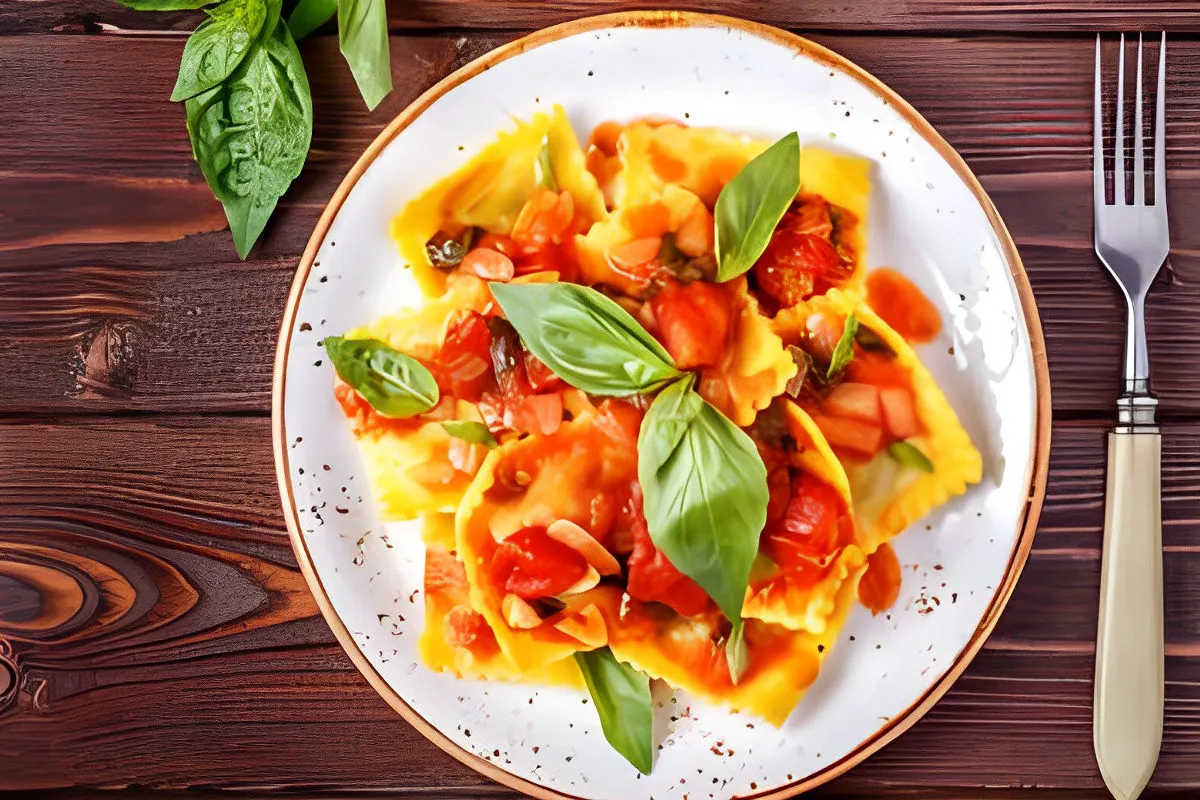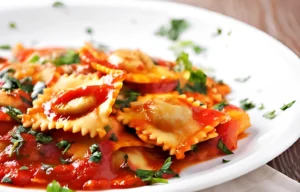The Delightful World of Ricotta Ravioli
Ravioli, a gem in the crown of Italian cuisine, has delighted palates for centuries. Among its many variations, ricotta ravioli stands out for its creamy filling and delicate flavor. This article embarks on a culinary journey, exploring the art of making ricotta ravioli from scratch. Whether you’re a seasoned chef or a curious food enthusiast, this guide promises to enrich your cooking repertoire.
A Brief History and Origin of Ravioli
Ravioli’s roots trace back to the Italian peninsula, where it first appeared in the 14th century. Initially, it was a luxury food reserved for the elite, but over time, it found its way into the hearts and homes of people across all social strata. Ricotta ravioli, in particular, showcases the simplicity and elegance of Italian cooking, using minimal ingredients to create a dish of sublime taste.
The Role of Ricotta in Italian Cuisine
Ricotta cheese, the star of this dish, is celebrated for its light texture and slightly sweet flavor. It’s a staple in Italian kitchens, versatile enough to be used in both savory dishes and desserts. In ricotta ravioli, it provides a creamy, luscious filling that pairs beautifully with a variety of sauces.
Overview of the Article’s Content
This comprehensive guide will walk you through every step of making ricotta ravioli. From selecting the perfect ingredients to mastering the dough and crafting the filling, we’ve got you covered. We’ll also delve into cooking techniques and serving suggestions to ensure your ravioli is nothing short of perfection. So, let’s roll up our sleeves and start our culinary adventure.
Crafting the Perfect Ricotta Ravioli
Creating ricotta ravioli that melts in your mouth with every bite is an art form. This section will guide you through selecting the right ingredients and preparing your workspace for this culinary endeavor.
Essential Ingredients
To begin, gather high-quality ingredients, as they are the foundation of flavorful ricotta ravioli. You will need:
- Fresh Ricotta Cheese: Opt for high-quality ricotta that’s creamy with a delicate texture. It should be free of excess water to ensure the filling is rich and not watery.
- Parmesan Cheese: Aged Parmesan adds depth and a salty tang to the filling, enhancing the ricotta’s subtle sweetness.
- All-Purpose Flour and Eggs: These are essential for making a tender, elastic dough that’s easy to work with.
- Nutmeg and Lemon Juice: These add layers of flavor to the filling, with nutmeg offering warmth and lemon juice providing a bright acidity.
- Salt and Pepper: Essential for seasoning the filling to perfection.
Preparing Your Workspace
A well-organized workspace streamlines the ravioli-making process. Here are some tips:
- Clear and Clean: Start with a clean, spacious countertop. You’ll need room to roll out the dough and assemble the ravioli.
- Gather Your Tools: Have a rolling pin, ravioli cutter, or mold, and a fork or pastry brush for sealing the ravioli edges.
- Ingredient Prep: Measure out all your ingredients beforehand. This keeps the process smooth and enjoyable.
Mastering the Ravioli Dough
The dough is the foundation of any ravioli dish, acting as a delicate envelope that encases the rich, flavorful filling. Achieving the perfect dough consistency is crucial for the success of your ricotta ravioli.
Mixing and Kneading
Begin by mixing your dough ingredients. You’ll need:
- 2 cups of all-purpose flour, creating a mound on your work surface with a well in the center.
- 3 large eggs, cracked into the well.
- A pinch of salt to enhance the dough’s flavor.
Using a fork, gently beat the eggs, gradually incorporating the flour from the sides of the well. As the mixture thickens, start kneading with your hands. Knead the dough for about 10 minutes, or until it becomes smooth and elastic. This process develops the gluten in the flour, giving the dough its necessary stretch and texture.
Rolling Out the Dough
Once your dough has rested for about 30 minutes, it’s time to roll it out. Divide the dough into four equal parts for easier handling. Flatten each piece slightly with your hand before passing it through a pasta machine or rolling it out with a rolling pin.
Aim for a thickness of about 1/16 inch. The dough should be thin enough to allow the flavors of the filling to shine through, yet sturdy enough to hold its shape during cooking. If using a pasta machine, start with the widest setting and gradually work your way to the desired thickness.
As you roll out your dough, keep the work surface and dough lightly floured to prevent sticking. This ensures a smooth, even texture that’s ideal for forming your ravioli.
The Ricotta Filling
The heart of any ricotta ravioli lies in its filling. A perfect blend of creamy ricotta, sharp Parmesan, and subtle seasonings can elevate your dish from good to unforgettable. Let’s dive into how to prepare a filling that’s bursting with flavor.
Choosing the Right Ricotta
The quality of ricotta cheese is paramount. Look for fresh, whole-milk ricotta that’s rich and creamy, with a smooth texture. Avoid ricotta with added stabilizers or excessive water content, as this can affect the consistency of your filling and the overall taste of your ravioli. If available, artisanal or homemade ricotta is your best bet for achieving the depth of flavor that this dish deserves.
Flavor Enhancements
To make the filling for your ricotta ravioli, you’ll need:
- 20 ounces of fresh ricotta cheese: Ensure it’s well-drained to remove excess moisture.
- 4 ounces of freshly grated Parmesan cheese: This adds a nutty, salty depth that complements the ricotta beautifully.
- A pinch of nutmeg: Nutmeg brings a warm, spicy undertone that enhances the filling’s complexity.
- 2 teaspoons of lemon juice: The acidity brightens the filling, cutting through the richness of the cheeses.
- Salt and freshly ground black pepper: Season to taste, balancing the flavors to perfection.
Combine the ricotta, Parmesan, nutmeg, and lemon juice in a bowl. Season with salt and pepper, then stir until the mixture is smooth and well-combined. Taste and adjust the seasoning as needed. The goal is a filling that’s flavorful enough to stand on its own, with a balanced blend of cheese, spice, and acidity.
Shaping and Filling Your Ravioli
Assembling ricotta ravioli is a rewarding process, where the dough and filling unite to form a classic Italian delicacy. This section will guide you through shaping and filling your ravioli, whether you’re using traditional handcrafting techniques or a ravioli mold for consistency.
Traditional Handcrafting Techniques
If you’re embracing the art of making ravioli by hand, you’ll appreciate the rustic charm and individuality each piece brings to your dish. Here’s how to shape and fill your ravioli without special tools:
- Prepare Your Dough and Filling: Roll out your dough into thin sheets, and have your ricotta filling ready.
- Forming the Ravioli: Place a sheet of pasta on a floured surface. Spoon small amounts of filling, about a teaspoon, onto the dough, spacing them evenly about 2 inches apart.
- Sealing the Ravioli: Lay another sheet of pasta on top. Press around the edges of each filling mound to seal the dough, ensuring there are no air pockets. Use a sharp knife or a pastry wheel to cut individual ravioli.
- Crimping the Edges: For a decorative touch and to ensure the ravioli are well-sealed, crimp the edges with a fork.
Using a Ravioli Mold
For those seeking uniformity and ease, a ravioli mold can be a great investment. Here’s how to use it:
- Drape the Dough: Place a sheet of rolled-out dough over the mold, ensuring it covers all cavities.
- Add the Filling: Spoon the ricotta mixture into each cavity of the mold. Be careful not to overfill.
- Cover with Dough: Lay a second sheet of dough over the filled cavities.
- Seal and Cut: Use a rolling pin to press and seal the ravioli. The mold will cut them into individual pieces as you roll.
Whether you choose the traditional method or a mold, the key is ensuring the ravioli are well-sealed to prevent them from opening during cooking. With your ravioli assembled, you’re just a few steps away from enjoying a delicious, homemade Italian feast.
Cooking Your Ricotta Ravioli to Perfection
After meticulously preparing and assembling your ricotta ravioli, the final step is cooking them to achieve the perfect texture and flavor. This section will guide you through the best practices for boiling your ravioli, ensuring they come out al dente and ready to be paired with your chosen sauce.
Boiling the Ravioli
- Bring a Large Pot of Water to a Boil: Salt the water generously. The salt enhances the pasta’s flavor, giving depth to the overall dish.
- Cook in Batches: To prevent overcrowding and sticking, cook the ravioli in small batches. Gently lower them into the boiling water.
- Stir Gently: Once you’ve added the ravioli to the pot, stir gently to ensure they don’t stick to the bottom or to each other.
- Monitor the Cooking Time: Fresh ricotta ravioli typically cook in about 3-4 minutes. They’re done when they float to the surface and the dough becomes slightly translucent.
- Taste Test: Before draining, taste a ravioli to ensure it’s cooked to your liking. The filling should be hot, and the dough should be tender yet firm, offering a slight resistance when bitten.
Tips for Perfect Cooking
- Use a Slotted Spoon: A slotted spoon is ideal for gently removing the ravioli from the boiling water, minimizing the risk of breaking them.
- Reserve Pasta Water: Before draining, reserve a cup of the pasta cooking water. This starchy water is perfect for thinning out sauces and helping them cling to the ravioli.
- Avoid Rinsing: After draining, do not rinse your ravioli. Rinsing removes the starches that help sauces adhere to the pasta.
Serving Your Ricotta Ravioli
After meticulously preparing and cooking your ricotta ravioli, it’s time to serve them in a way that highlights their delicate flavors and textures. The right sauce and garnishes can transform your ravioli into a memorable meal. Let’s explore some serving and pairing options that will make your ricotta ravioli shine.
Sauce Pairings
The choice of sauce is crucial in complementing the creamy richness of the ricotta filling. Here are a few suggestions:
- Sage Brown Butter Sauce: A classic pairing, the nutty, aromatic flavor of brown butter infused with sage leaves accentuates the subtle sweetness of the ricotta.
- Marinara Sauce: For a more traditional approach, a simple, vibrant marinara sauce adds a touch of acidity and tomatoey goodness that pairs beautifully with the cheese filling.
- Pesto Sauce: A fresh basil pesto brings a bright, herby contrast to the creamy ravioli, perfect for a lighter option.
When choosing your sauce, consider the balance of flavors. You want a sauce that complements the ravioli without overpowering the delicate taste of the ricotta filling.
Garnishing and Presentation
The final touches can elevate your dish from great to extraordinary. Here are some garnishing tips:
- Grated Parmesan or Pecorino Cheese: A sprinkle of cheese adds a salty, umami kick that enhances the overall flavor profile.
- Fresh Herbs: Chopped parsley, basil, or chives not only add a pop of color but also freshness to each bite.
- A Drizzle of High-Quality Olive Oil: For a simple yet elegant finish, a drizzle of extra virgin olive oil can add depth and richness.
Presentation matters. Serve your ricotta ravioli on a warm plate, spoon over your chosen sauce, and apply your garnishes with care. A well-presented dish invites the eyes to feast first, setting the stage for a delightful culinary experience.
Frequently Asked Questions
What is Ricotta Ravioli Made Of?
Ricotta ravioli is a classic Italian dish made with a simple yet delicious combination of ingredients. The dough is typically made from all-purpose flour, eggs, and a pinch of salt, rolled out into thin sheets. The filling centers around ricotta cheese, often enhanced with Parmesan, nutmeg, lemon juice, and seasoning for added flavor. These components come together to create a dish that’s both comforting and sophisticated.
What is Ravioli Filling Made Of?
Ravioli filling can vary widely, but for ricotta ravioli, the filling is primarily made of ricotta cheese. This creamy, mild cheese provides the base, while additional ingredients like grated Parmesan cheese, spices (such as nutmeg), lemon juice, and seasoning are added to enrich the flavor. The goal is a balanced, flavorful filling that complements the pasta dough.
Do I Have to Drain Ricotta for Ravioli?
Yes, draining the ricotta cheese is an important step when preparing ravioli filling. Excess moisture in the ricotta can make the filling too wet, leading to potential issues when sealing the ravioli or causing them to burst during cooking. Draining the ricotta ensures the filling remains creamy and rich without compromising the texture of the final dish.
Does Ravioli Always Have Ricotta?
No, ravioli does not always contain ricotta. While ricotta ravioli is a popular and traditional variety, ravioli can be filled with a wide range of ingredients, including meats, vegetables, and other cheeses. The versatility of ravioli is one of its charms, allowing for endless creativity in the kitchen. However, ricotta ravioli remains a beloved choice for its delicate flavor and creamy texture.
Classic Ricotta Ravioli Recipe
Indulge in the timeless elegance of Italian cuisine with this classic ricotta ravioli recipe. Perfectly balanced flavors wrapped in tender pasta dough make this dish a delightful experience for any occasion.
Ingredients:
For the Pasta Dough:
- 2 cups all-purpose flour, plus extra for dusting
- 3 large eggs
- 1/2 teaspoon salt
For the Ricotta Filling:
- 20 ounces fresh ricotta cheese, drained
- 4 ounces freshly grated Parmesan cheese
- 1/4 teaspoon ground nutmeg
- 2 teaspoons lemon juice
- Salt and freshly ground black pepper, to taste
Enjoy the rich and comforting flavors of homemade ricotta ravioli, a dish that beautifully showcases the simplicity and elegance of Italian cooking. Whether for a special occasion or a cozy dinner at home, this recipe promises to delight your senses and leave you craving more.



